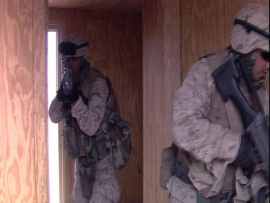
Sangita Gopal: KARUNA, Compassion/Com-passion/Sarah and Negar
Thank you Sarah Husain for raising a number of remarkable questions with regard to compassion/com-passion - you are absolutely right - one can never "feel" what it is like to be under attack when one is safe. The related question that interests me is do two people in the same situation - both of whose homes are under attack - feel for each other? Is that "feeling for" - arising from a shared experience of oppression - the basis of their collective identity or is it rather a need for justice that unites them?
Given that justice always addresses a unitary subject - will the very process of getting justice again individuate these two homeless people, break apart that collectivity which issued the call for justice? Justice tends to treat the collective as "one" - "the Iraqi people" for eg. - thereby fixing permanently the contingent experience that created the collective - the homes under attack - and that fixing of identity that ensues from the vantage of those who enter the field of justice evades and erases all other aspects of being - one may be homeless NOW but one is far from destitute - it is the violence of this erasure - whereby the totality of the being is forgotten in the face of the single act of suffering - that I think Sarah alerts us to.
Sarah reminds us that feeling compassion for another creature because it suffers might be absolutely the wrong way to approach the issue of compassion - it only confirms privilege and evokes guilt. I think Sarah's point about "photographed" images of suffering goes to Negar's keen meditation on the limits of realism in capturing what it means to live underfire - images of suffering that are "less real" (than photographs) might block the operation of compassion and reduce the space that opens up between the looker and the one looked at/the feeler and the one felt for. What, I wonder, is the aesthetic register of compassion.
I will close by offering another articulation of compassion that I found in Amitav Ghosh's novel "The Glass Palace" that goes to our discussion. It is on page 210-11 in the Ravi Dayal edition.
Here Dolly has been nursing her very sick child Dinu. One night as she steps away from his hospital bed, she sees the shrouded corpse of a child - a boy of her son's age and not unlike him in build. She breaks down and crys hysterically - overwhelmed by guilt and relief.
"Again that night, she had not been able to sleep. She'd thought of the child's body; she'd thought of what her life would would be like in Dinu's absence; she'd thought of the dead boy's mother. She'd begun to cry - it was as though her voice had merged with that of the unknown woman; as though an invisible link had arisen between them all - her, Dinu, the dead child, his mother. ......
She remembered a word he's often used - KARUNA - one of the Buddhas' words, Pali for compassion, for the immanence of all living things in each other, for the ATTRACTION of life for its likeness."
(capitalization not in original)
> Sangita Gopal
Given that justice always addresses a unitary subject - will the very process of getting justice again individuate these two homeless people, break apart that collectivity which issued the call for justice? Justice tends to treat the collective as "one" - "the Iraqi people" for eg. - thereby fixing permanently the contingent experience that created the collective - the homes under attack - and that fixing of identity that ensues from the vantage of those who enter the field of justice evades and erases all other aspects of being - one may be homeless NOW but one is far from destitute - it is the violence of this erasure - whereby the totality of the being is forgotten in the face of the single act of suffering - that I think Sarah alerts us to.
Sarah reminds us that feeling compassion for another creature because it suffers might be absolutely the wrong way to approach the issue of compassion - it only confirms privilege and evokes guilt. I think Sarah's point about "photographed" images of suffering goes to Negar's keen meditation on the limits of realism in capturing what it means to live underfire - images of suffering that are "less real" (than photographs) might block the operation of compassion and reduce the space that opens up between the looker and the one looked at/the feeler and the one felt for. What, I wonder, is the aesthetic register of compassion.
I will close by offering another articulation of compassion that I found in Amitav Ghosh's novel "The Glass Palace" that goes to our discussion. It is on page 210-11 in the Ravi Dayal edition.
Here Dolly has been nursing her very sick child Dinu. One night as she steps away from his hospital bed, she sees the shrouded corpse of a child - a boy of her son's age and not unlike him in build. She breaks down and crys hysterically - overwhelmed by guilt and relief.
"Again that night, she had not been able to sleep. She'd thought of the child's body; she'd thought of what her life would would be like in Dinu's absence; she'd thought of the dead boy's mother. She'd begun to cry - it was as though her voice had merged with that of the unknown woman; as though an invisible link had arisen between them all - her, Dinu, the dead child, his mother. ......
She remembered a word he's often used - KARUNA - one of the Buddhas' words, Pali for compassion, for the immanence of all living things in each other, for the ATTRACTION of life for its likeness."
(capitalization not in original)
> Sangita Gopal

